Traditionally made from cabbage and a saltwater brine, sauerkraut is fermented for several weeks. Homemade sauerkraut is amazing and doesn’t resemble store bought at all, plus it’s easy and cheap to make and filled with probiotics. Let’s make homemade fermented sauerkraut!
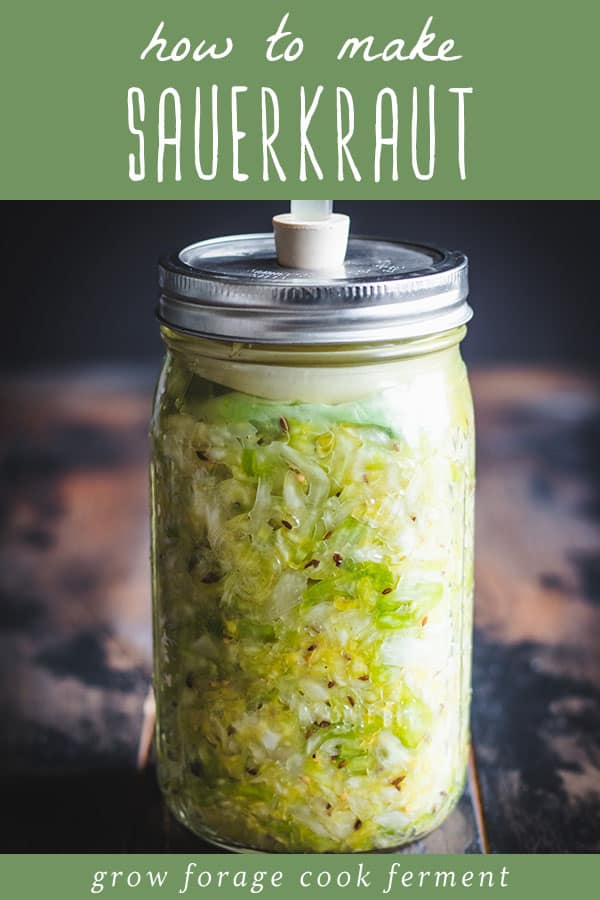
Want to save this post for later?
What is Sauerkraut?
I don’t know about you, but I hated sauerkraut when I was a kid. The stuff that came off the grocery store shelf smelled funny and was mushy and weird tasting.
I was even one of those kids that liked weird tasting things, but I just couldn’t wrap my head around sauerkraut. What on earth was it?
Turns out, sauerkraut is one of the original ferments of its time!
Traditionally made from cabbage and a saltwater brine, it is fermented for several weeks (or months, even!) before it is eaten.
Lactic acid bacteria, which is present naturally on all plants, does all the work for you and turns the cabbage into something awesome to put on your sandwich or hot dog.
Homemade sauerkraut is amazing and doesn’t resemble store bought at all, plus it’s super easy and cheap to make. Here’s how to do it!
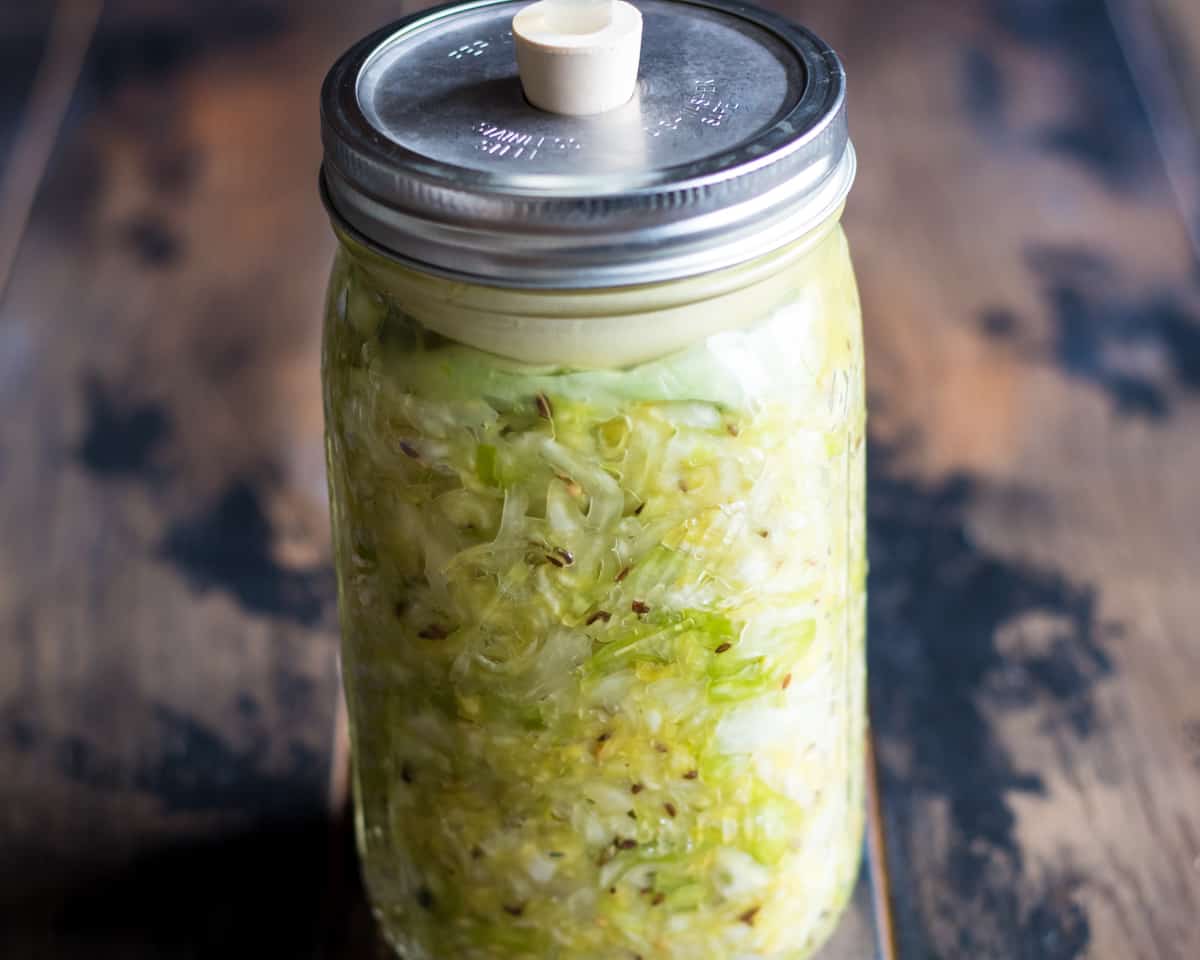
Get more recipes for canning, fermenting, quick pickling, dehydrating, and freezing so that you can enjoy your summer produce year-round in my ebook Preserving the Garden Harvest!
Wild Fermentation Book
Let me start by recommending these books by Sandor Ellix Katz, Wild Fermentation and The Art of Fermentation.
These books are awesome and I have learned so much from them, including how to make this sauerkraut. Sandor Katz is my hero!
They would make a great gift for someone who enjoys fermenting or is interested in learning more!
Related: 12 Best Books on Fermenting and Homebrewing

Homemade Sauerkraut Recipe
This homemade fermented sauerkraut recipe is so easy to make! It is the perfect recipe for beginner’s to fermenting.
Sauerkraut Ingredients and Equipment
All you really need to make sauerkraut is cabbage and salt. I like to add some spices too, but it’s not necessary at all.
Any type of cabbage will work to make sauerkraut. I prefer to use just regular green cabbage, but purple, savoy, or napa all work equally well.
You can also add other shredded veggies to the mix like carrots, beets, onions, garlic, ginger, or turmeric.
For the spices I mention use anything you like, but whole spices work best.
In this recipe I went classic and used about a tablespoon each of dill seed, caraway seed, and mustard seed. Juniper berries are another common addition.
It’s helpful to have a fermentation weight of some kind and an airlock, but they aren’t required.
This recipe makes about one quart of sauerkraut. If you want more you can double the recipe and ferment it in a half gallon mason jar.
If you want even more sauerkraut you might want to invest in a ceramic crock.
I’ve made all kinds of vegetable ferments in many different vessels in the past, namely large wide mouth jars (which are also great for making kombucha).
You can also use something you already have, just make sure it’s glass or ceramic. Avoid using metal as it can react with the fermentation process or plastic because it can leach toxic chemicals.
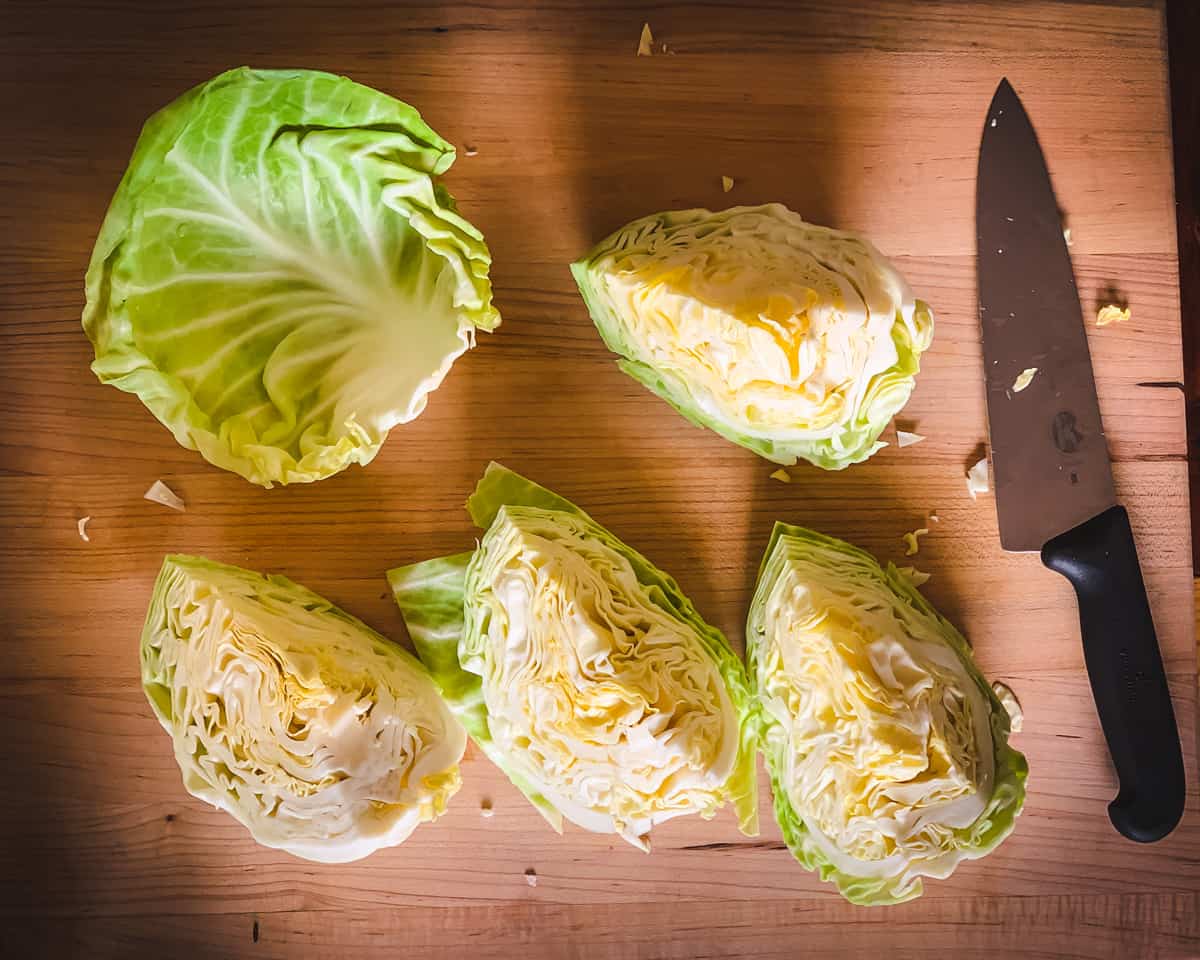
Shred, Salt & Mash the Cabbage
Start with a two pound cabbage per quart of sauerkraut. Peel away the outermost leaf from the cabbage and set it aside to use later.
Shred up the rest of the cabbage as finely as possible. A cheese grater works well for this, but you can also slice it thinly with a knife.
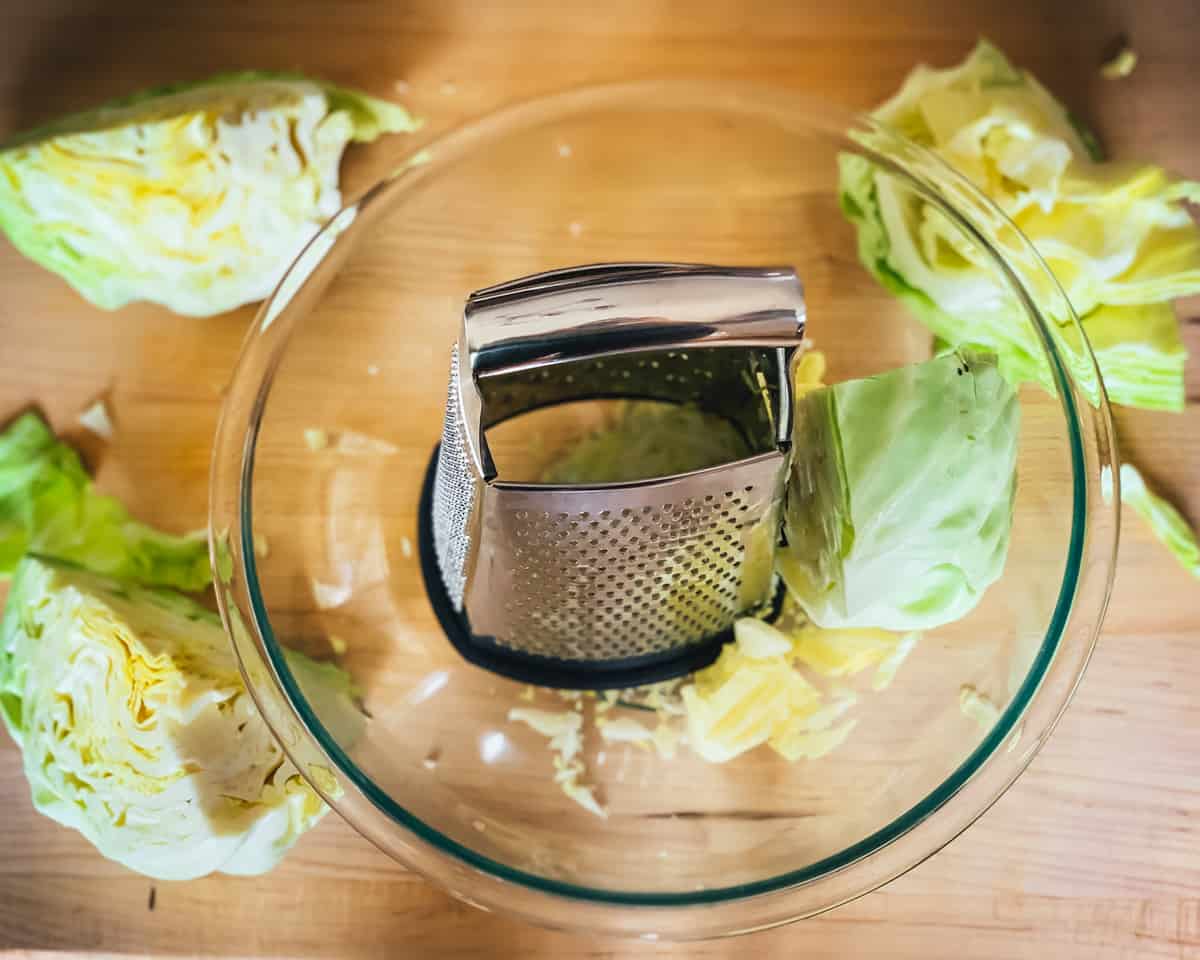
Put the shredded cabbage into a big wide bowl.
Sprinkle the salt all over the cabbage and stir it around to thoroughly coat everything.
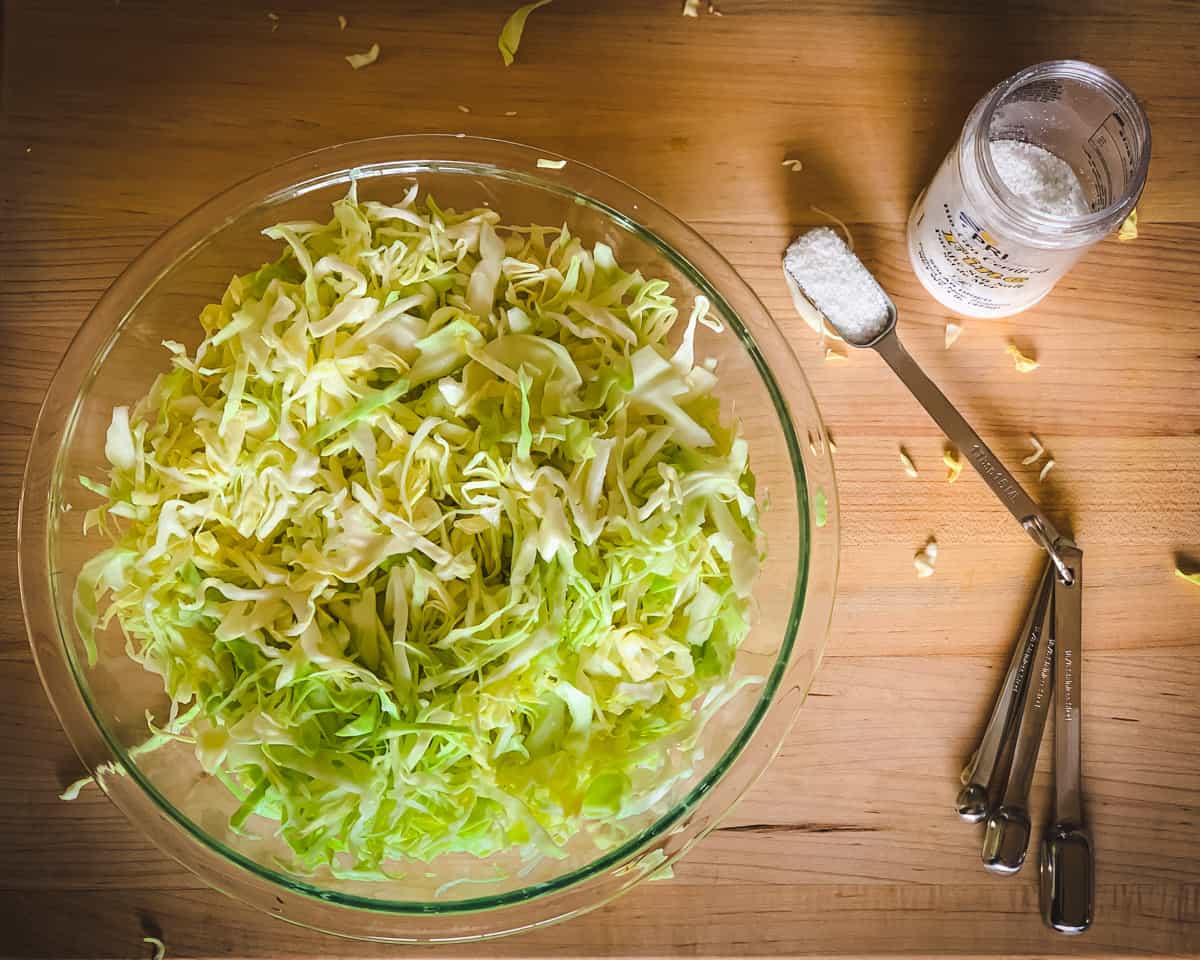
Then add the spices to the cabbage.
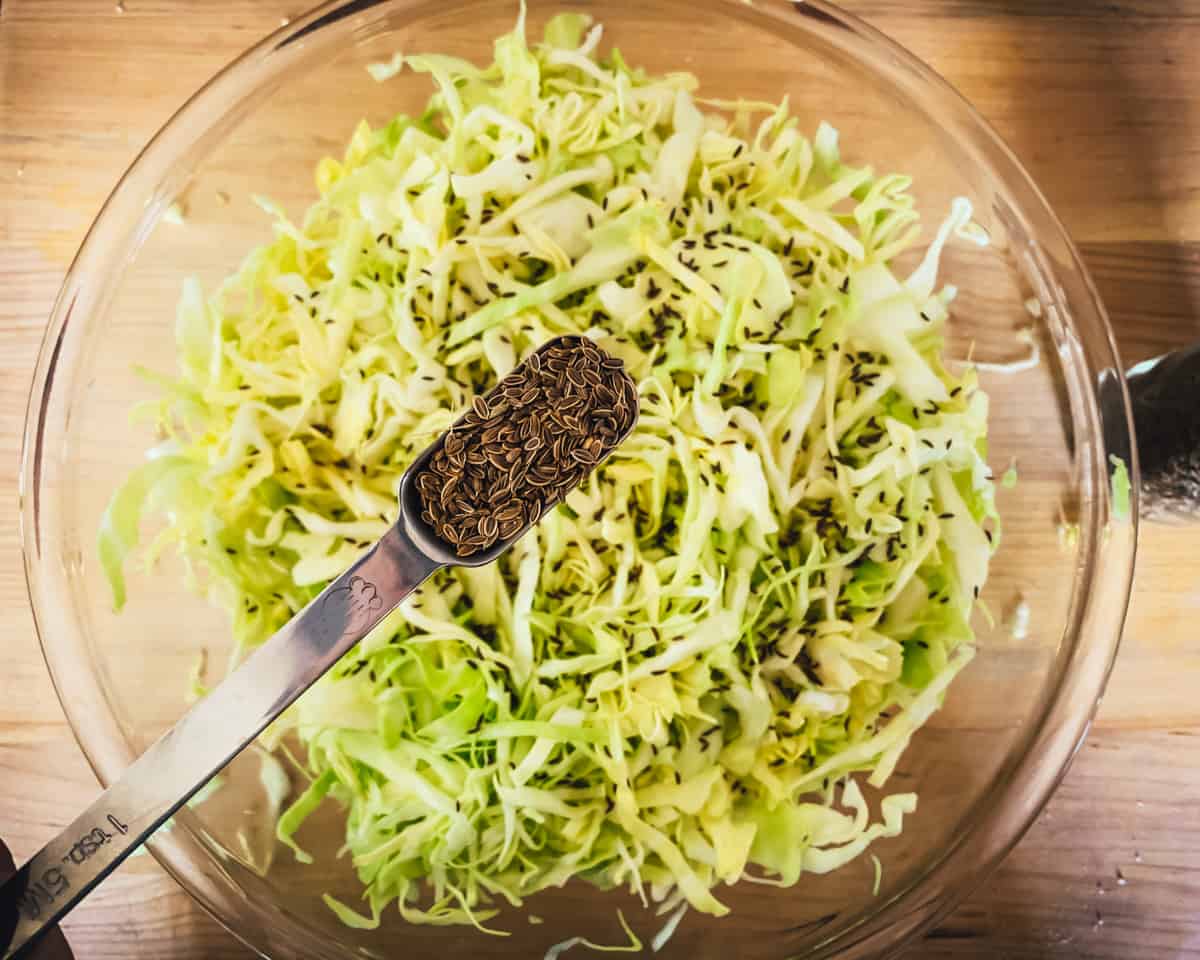
Then comes the fun part, mashing it all around! Really mash it good to bruise the cabbage and break down the cell walls which will release juice.
I use a potato masher, but anything big and heavy will work. There is even such thing as a fermentation tamper if you want to give that a try!
You can also squeeze the cabbage with your hands.
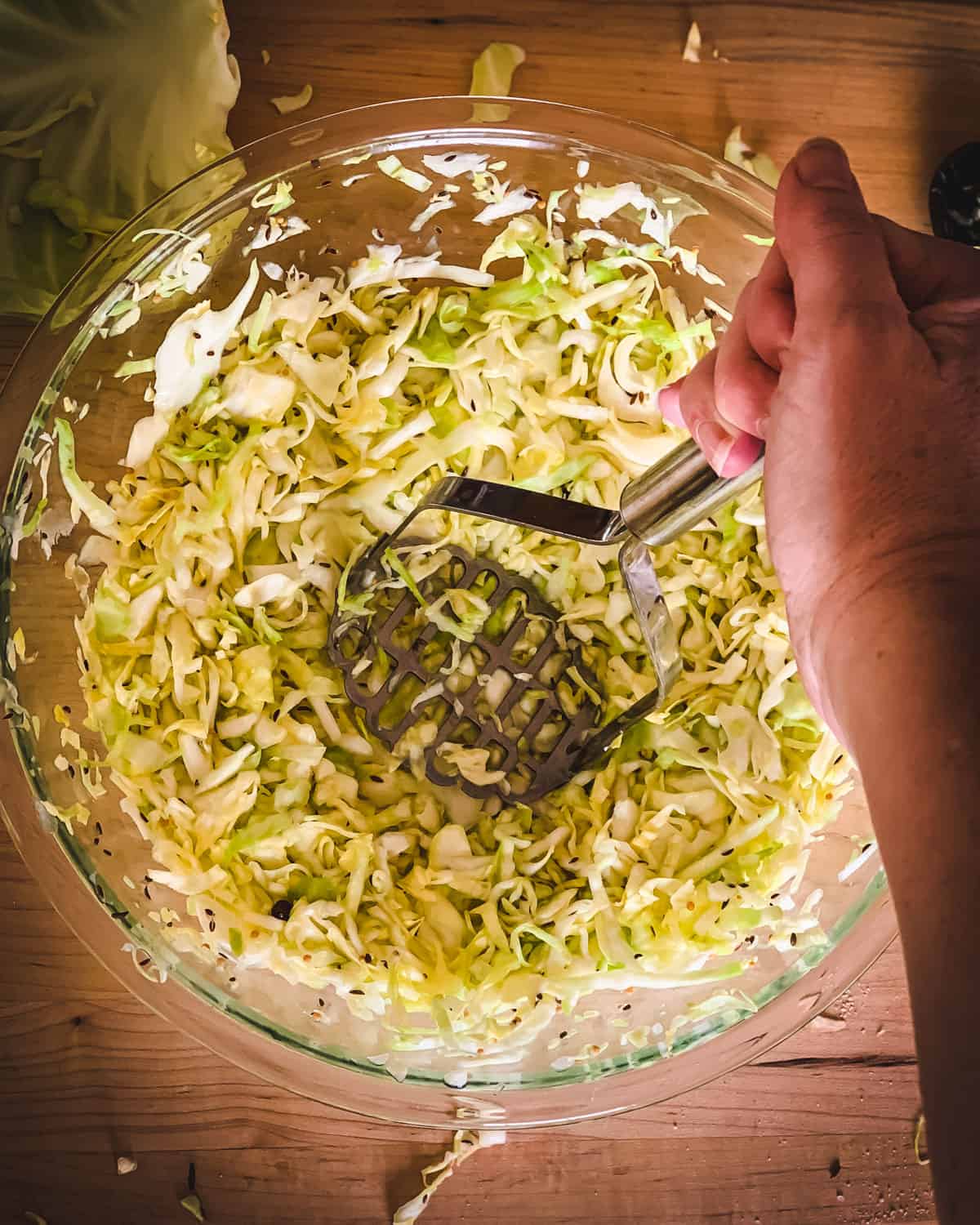
Liquid should start forming in the bottom of the bowl, that’s good!
After mashing the cabbage for a while it will be much more juicy and will have lost quite a bit of its volume.
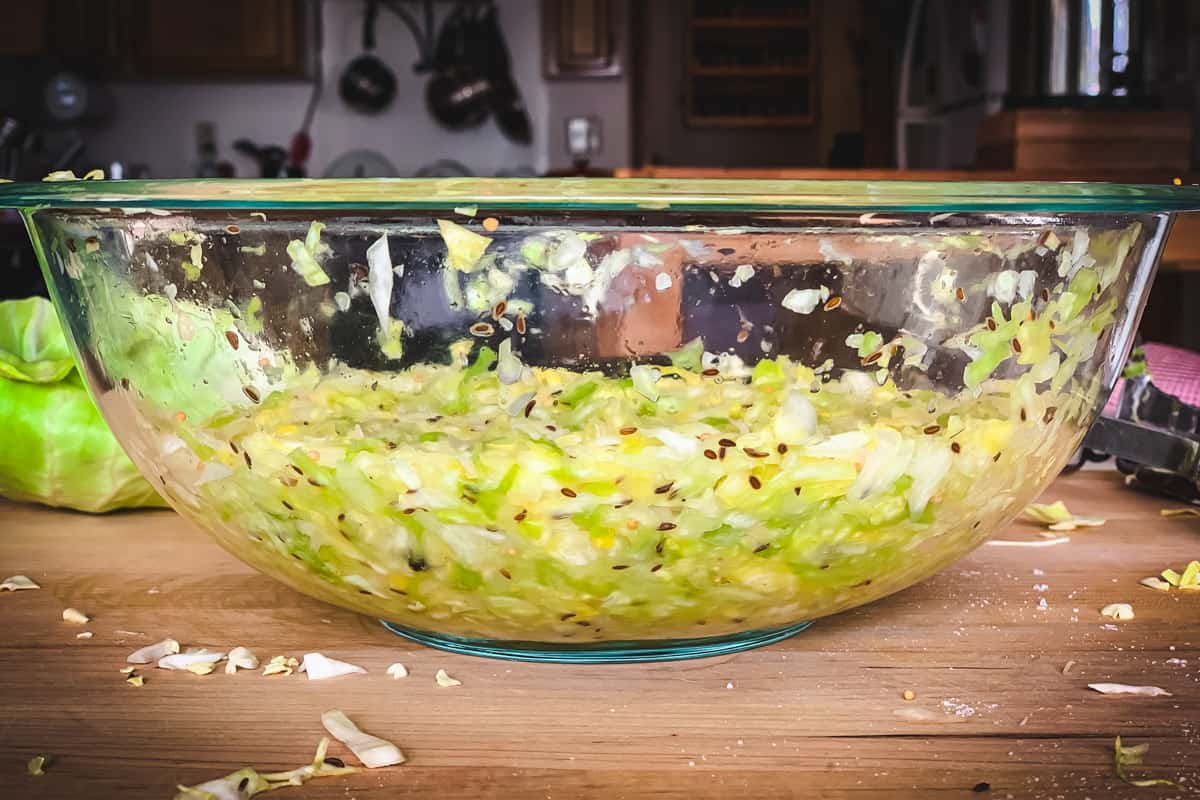
Pack the Cabbage into a Fermentation Jar
When it gets to this stage it’s time to pack the cabbage into a quart jar.
Use a wooden spoon (or a fermentation tamper if you have one) to pack it into the jar. It should be full of liquid and when you press down on it you should see liquid rise up over the cabbage.
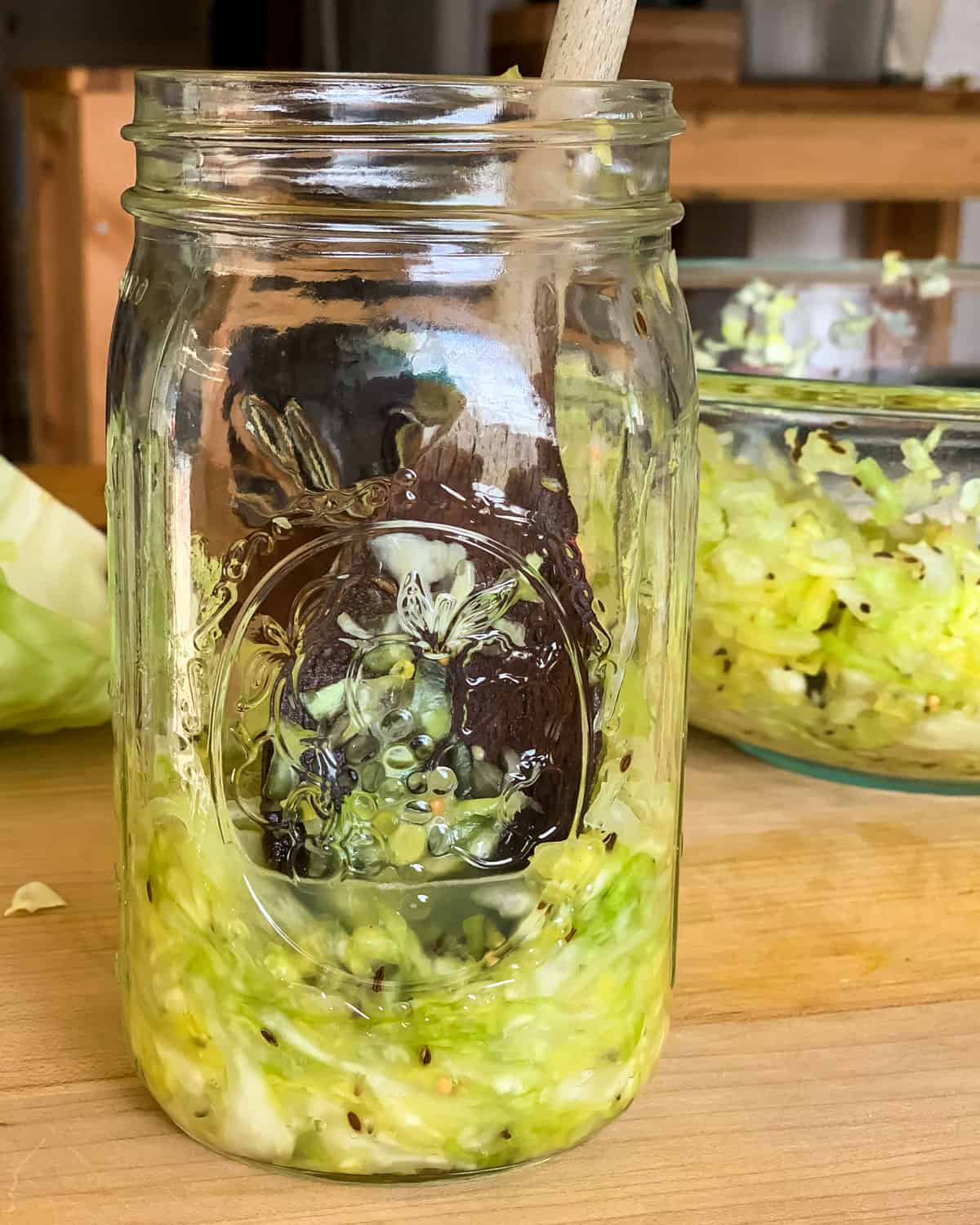
Once you pack all of the cabbage into the jar you should have a brine that covers the cabbage.

If for some reason your cabbage didn’t release enough liquid (this can happen with not so fresh cabbage) you can make some extra brine.
Make a ratio of 1 tbsp kosher salt to 1 cup water and add it to the jar until the cabbage covered.
Then put the reserved cabbage leaf on top of the shredded cabbage which will help to keep all of the little cabbage pieces under the brine.
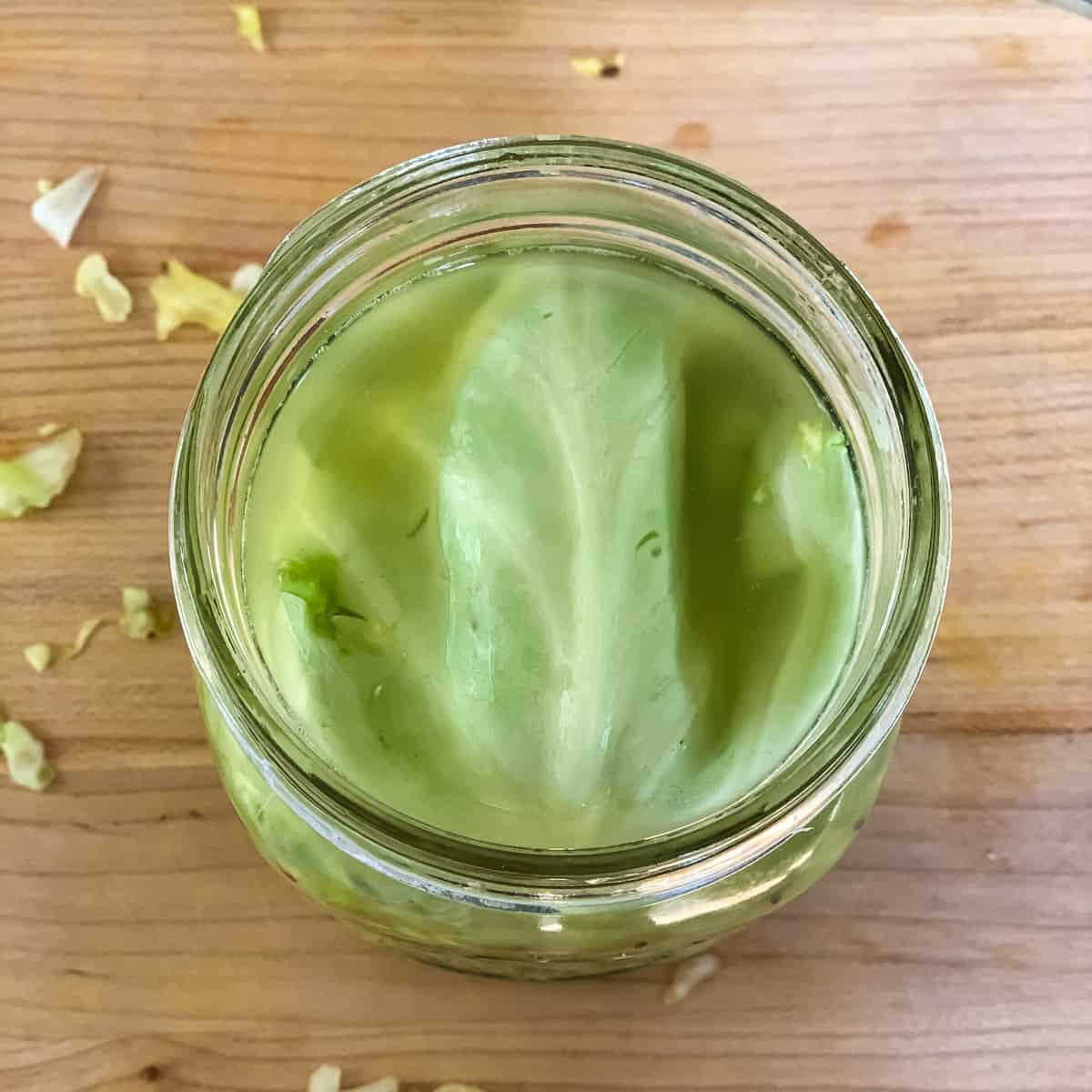
Then add a fermenting weight of some kind on top of the cabbage leaf. This will keep everything under the brine during the fermentation process.
I love using a ceramic fermenting weight but these glass weights are nice too.
You can also get creative and use a smaller jar full of water or a clean river stone as a weight.
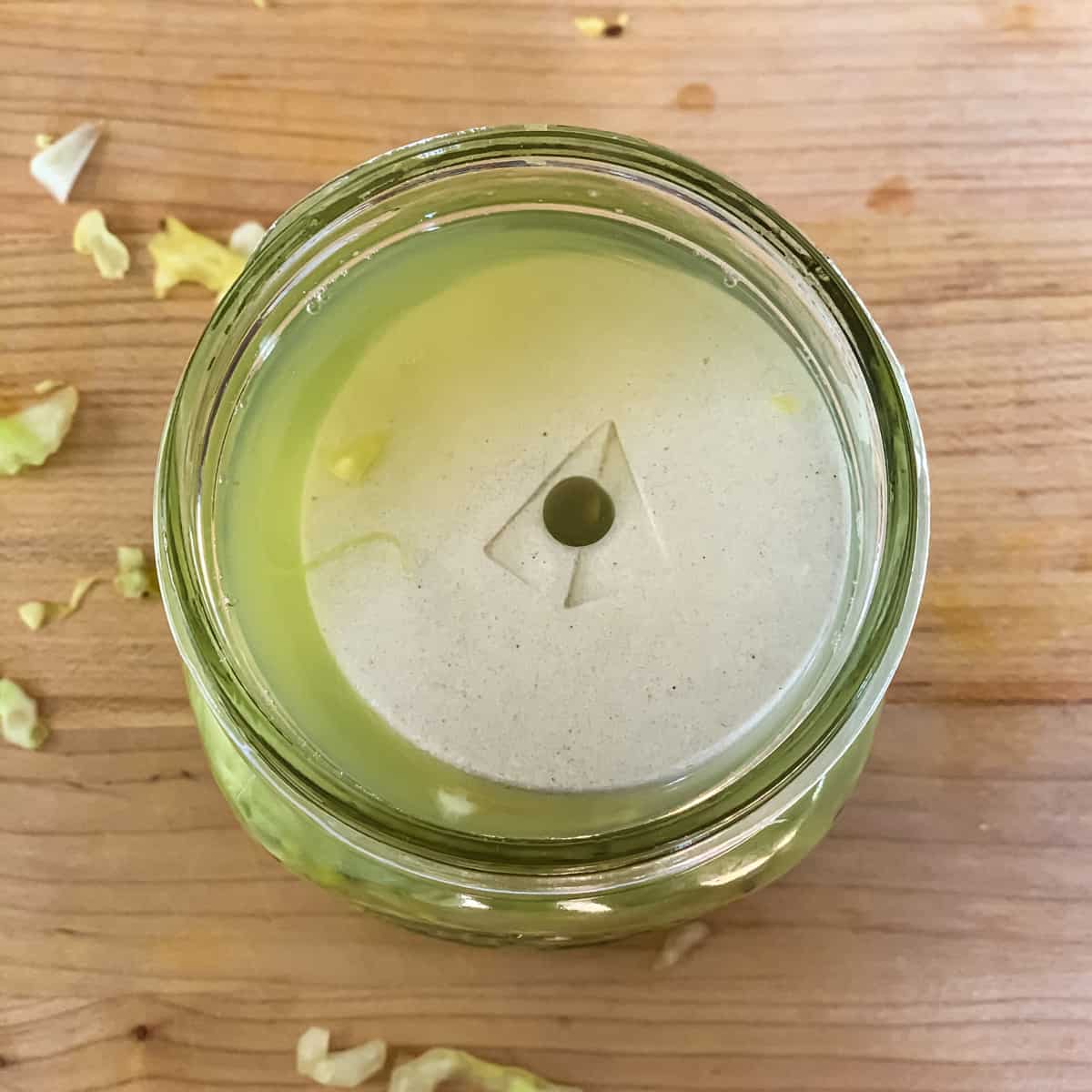
Ferment the Sauerkraut
Cover the jar with a fermenting airlock system, or you can simply cover the whole thing with a cloth or towel.
Put the jar in a quiet corner of your kitchen to ferment.

Push down on the weight a few times for the first day whenever you think of it, and make sure the brine is completely covering the cabbage.
It may not be for the first 24 hours and that’s ok, but if it’s still not after that you need to add more brine.
Taste the kraut as you go along, and when it’s to your liking that means it’s done. This could take 2-3 weeks or even longer.
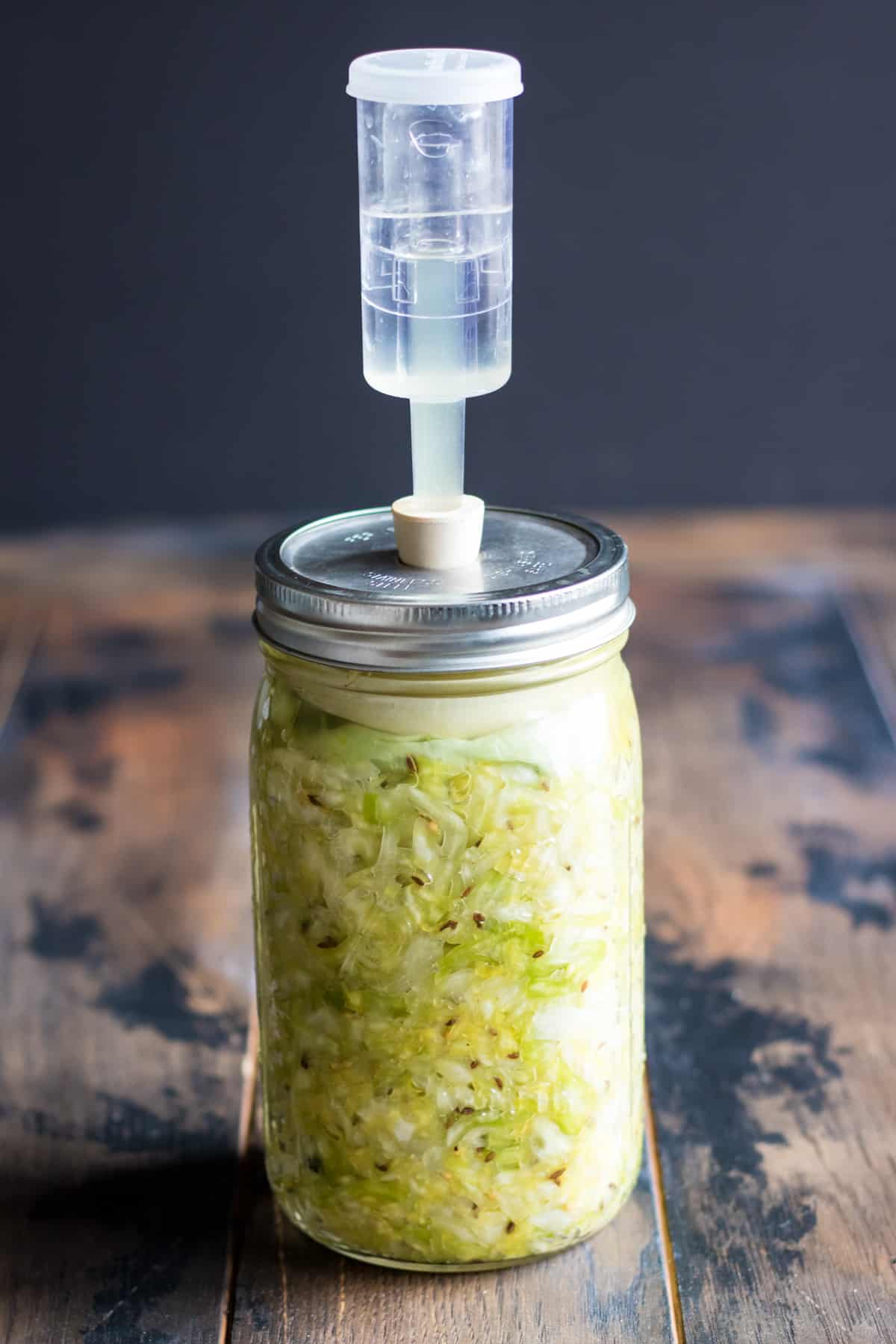
Don’t worry if white scum forms on the top of the sauerkraut, it’s harmless kahm yeast. This is more common if an airlock is not used. Just scrape it off as best you can before you eat your kraut.
Once it has finished fermenting, store the sauerkraut in a covered jar in the refrigerator. It will last for many months or even longer.
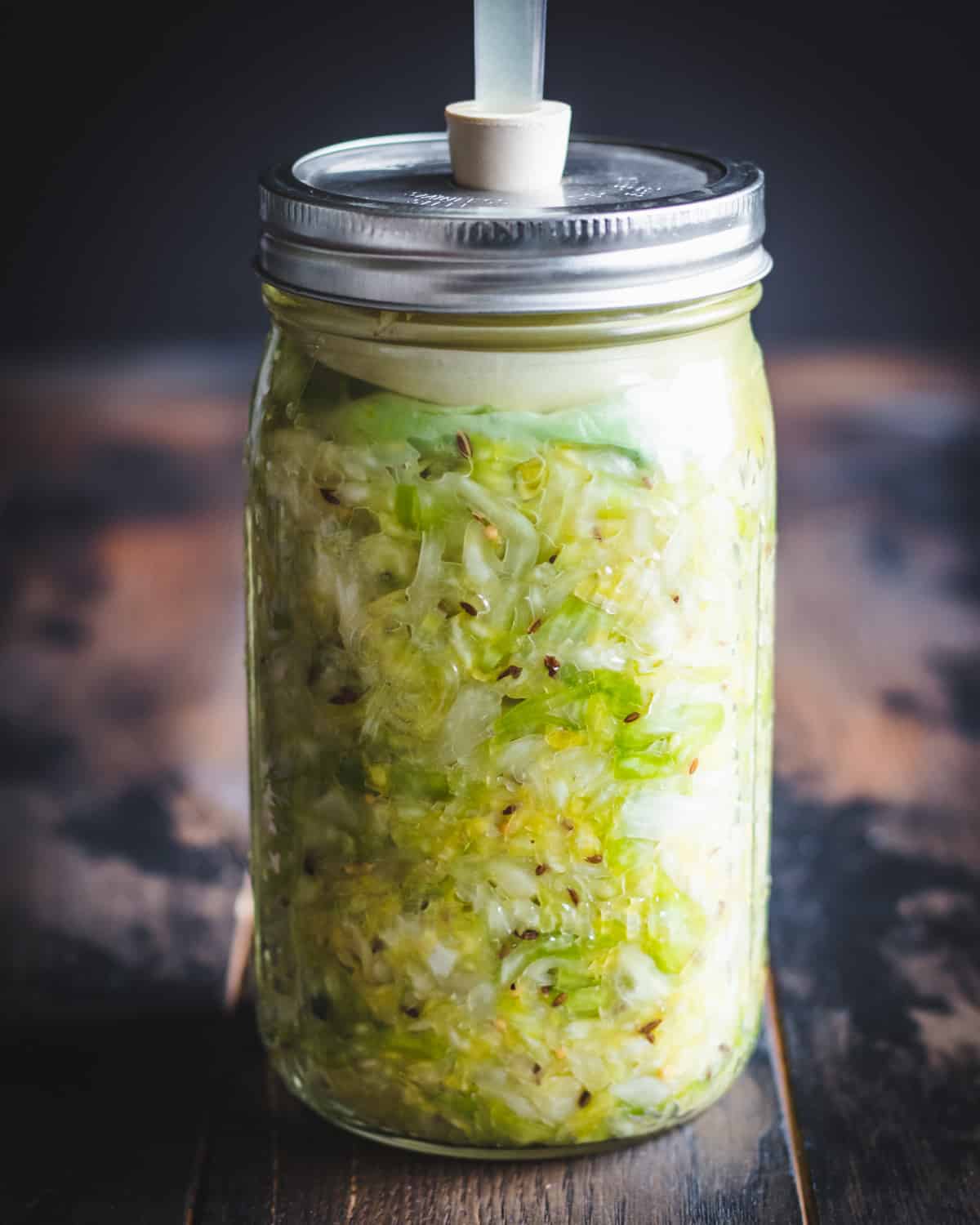
How to Use Sauerkraut
This traditionally fermented sauerkraut is so good! It’s perfect on a homemade Reuben sandwich.
Sauerkraut pairs perfectly with my no knead sourdough rye bread and is the perfect accompaniment to my nitrate-free corned beef.
Sauerkraut is also wonderful when added to a hot dog! It gives anything an extra probiotic boost.
Even my little one loves my homemade sauerkraut! I probably would have loved this version when I was a kid too.
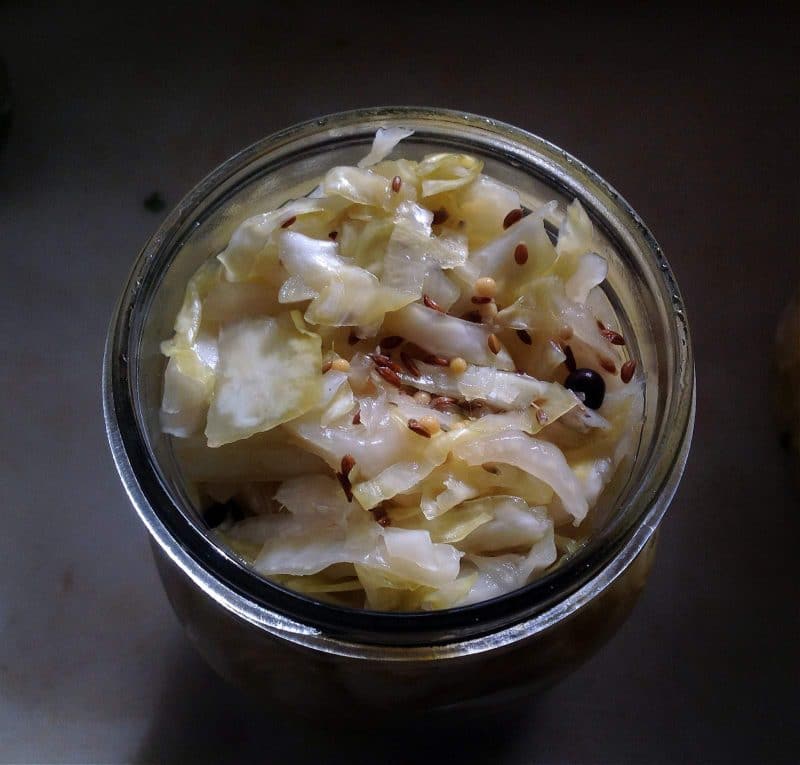
More Fermented Vegetable Recipes
Here are more delicious recipes for fermented vegetables!
- How to Make Kimchi
- Fermented Garlic
- Fermented Cherry Tomatoes
- Fermented Green Tomatoes
- Fermented Asparagus with Garlic
- Fermented Cucumber Pickles
- Fermented Dilly Beans
Sauerkraut
Equipment
Ingredients
- 2 pound cabbage any variety
- 1 tbsp kosher, pickling, or sea salt
- 1 tbsp dill seed
- 1 tbsp caraway seed
- 1 tbsp mustard seed
Instructions
- Peel away the outermost leaf from the cabbage and set it aside to use later.
- Shred up the rest of the cabbage as finely as possible. A cheese grater works well for this, but you can also slice it thinly with a knife.
- Put the shredded cabbage into a big wide bowl. Sprinkle the salt all over the cabbage and stir it around to thoroughly coat everything. Then add the spices to the cabbage.
- Mash the cabbage with a potato masher, wooden spoon, or a fermentation tamper. Really mash it good to bruise the cabbage and break down the cell walls which will release juice.
- After mashing the cabbage for a while it will be much more juicy and will have lost quite a bit of its volume. When it gets to this stage it’s time to pack the cabbage into a quart jar.
- Use a wooden spoon to pack it into the jar. Once you pack all of the cabbage into the jar you should have a brine that covers the cabbage.
- Put the reserved cabbage leaf on top of the shredded cabbage which will help to keep all of the little cabbage pieces under the brine.
- Add a fermenting weight on top of the cabbage leaf. This will keep everything under the brine during the fermentation process.
- Cover the jar with a fermenting airlock system, or you can simply cover the whole thing with a cloth or towel. Put the jar in a quiet corner of your kitchen to ferment.
- Push down on the weight a few times for the first day whenever you think of it, and make sure the brine is completely covering the cabbage. It may not be for the first 24 hours, but if it’s still not after that you need to add more brine.
- Taste the kraut as you go along, and when it’s to your liking that means it’s done. This could take 2-3 weeks or even longer.
- Once it has finished fermenting, store the sauerkraut in a covered jar in the refrigerator. It will last for many months or even longer.
Notes
- Any type of cabbage will work to make sauerkraut. I prefer to use just regular green cabbage, but purple, savoy, or napa all work equally well.
- You can also add other shredded veggies to the mix like carrots, beets, onions, garlic, ginger, or turmeric.
- If for some reason your cabbage didn’t release enough liquid (this can happen with not so fresh cabbage) you can make some extra brine. Make a ratio of 1 tbsp kosher salt to 1 cup water and add it to the jar until the cabbage covered.
- Don’t worry if white scum forms on the top of the sauerkraut, it’s harmless kahm yeast. This is more common if an airlock is not used. Just scrape it off as best you can before you eat your kraut.

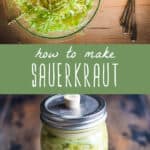
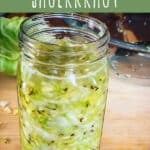

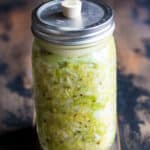

First time fermenting cabbage and it’s on its second day and I noticed bubbles which I guess is good. My concern is that the airlock lid had a strange smell. I emptied the airlock top and put in fresh water.
That’s totally normal as the fermentation goes along.
Once it ferments can you store it without the weight in the frig? Just keep it covered?
Yes!
Hi Colleen
Is there a way to seal the jar of sauerkraut so that it’s shelf stable once it’s done fermenting?
The only way do that is with water bath canning, but you’ll lose all the fermented goodness with by boiling it. Because kraut is fermented, it’ll last a long time refrigerated in a jar.
How long will a ferment last in the fridge in jars?
And should the jars be sterilized prior to filling them with the kraut?
Hi Tanya. Fermented kraut will last a long, long time in the fridge, many months. It’s hard to say how long exactly. I also don’t sterilize the jars, only wash with hot, soapy water.
You can do a wet bath and can sauerkraut so it last longer correct? My Mom made and canned sauerkraut all the time.
You can, but you’ll lose all the fermented goodness once the jars are heated.
My kraut started turning brown on the top. It is covered in liquid. Is the brown ok or is it spoiling?
Hi Sharell. It sounds like it’s beginning to oxidize or it’s too warm where you’re letting your kraut ferment. Either way, it’s perfectly fine and not spoiled. I would try moving it somewhere cooler.
First i need to say, I love your posts! I’m making some sauerkraut with my savoy cabbage. I have dill weed but not seed…will that work?
Yup!
Can you vacuum seal the jars when fermentation has reached your desired level in order to store it without refrigeration longer?
Hi Beverly. Lacto fermentation is anerobic. meaning it doesn’t need oxygen to ferment, so vacuum sealing would do no good in this case. To keep your sauerkraut at your desired level of fermentation, refrigerating is the only way to go.
Is it it okay (safe) to open this the day after initially preparing it (less than 24h later) to add some brine? My brine level from just the cabbage is lower than I realized and there is some cabbage uncovered. I want to make sure it’ll be safe to eat still (in a few weeks, of course!) if it’s been a day without enough brine….? I’m using Ball fermentation lids, if that matters at this point. Thank you for your time!
Hi Alex. That’s totally fine!
Thank you! Got it covered and very excited for my first ever home made sauerkraut! 🎉
Wonderful! Enjoy!
you’re actually a excellent webmaster. The web site loading velocity is amazing. It sort of feels that you are doing any unique trick. Also, The contents are masterwork. you have performed a magnificent task in this subject!
My thought is that sauerkraut has been made for centuries before refrigeration existed. Does it indeed need to be kept in the fridge at all or is that just a modern “nicety” or so that no one gets sued for something going wrong??
Hi Anthony. As long as the cabbage is submerged under the brine, it’ll stay good for many months unrefrigerated. You may need to add additional liquid to make up for any that has evaporated. Some people, like myself, prefer to refrigerate the kraut to keep it someone crunchy. The longer it ferments, the more it breaks down and becomes softer and softer.
Great post,
I also love how you dont make us go out and buy something we don’t already have. Can I try black salt with this and also can I use Apple Cider Vinegar or lemon juice? just comming up with some creative sources of fermentation brine out of what I have . :D
Hi Amber. I have never used black salt. If it’s free from preservatives, you can use it. Personally, I wouldn’t add additional acidity to a lacto ferment as it has a nice tang on its own.
Hi Amber. From what I have read over, and over, again, if we add vinegar to our fermented foods such as this recipe, the vinegar kills the good bacteria we are striving for. (Note: vinegar kills good and the bad bacteria..) <3 Just an FYI
I added a jar of cowboy candy liquid to one of my batches. It is soooooo good. I also omitted mustard seed and added tumeric and garlic powder instead
What a great and delicious sounding idea. I’ll have to try that!
Anyone ever add a bit of beer and reduce the water?
No, but you could try it and let us all know it goes. I’ve read, that using unpasteurized beer is the way to go, but again, I haven’t tried it.
just bought a 4 gallon crock at a farm auction this weekend specifically to make this, hope it works out!
Wonderful, Jim! Let me know how it turns out!
I love making Krout! My favourite time to make it is cabbage season, all those fresh from the garden cabbages give up so much juice for fermenting. I make a 5gal pail full, ferment it, jar it, keep some and give lots away to friends and family. Now they are calling and putting in orders 🤓
Can I process this so I can keep it in my pantry? I planted a ton of cabbage just to make sauerkraut, but don’t have enough refrigerator space…
Hi Lori. Technically, you could can your sauerkraut, but you’d kill off the enzymes that you cultivated in the fermentation process. Another option is to store your kraut in the freezer which may not kill off all the healthy bacteria.
Just made the Sauerkraut today. Forgot to add garlic, but it’s going to be great anyway. Thank you for such quality recipes ! Health is a concern these days and healthy recipes are always appreciated !
Thanks for all you do
You’re welcome! I’m so glad you liked it!
What kind of garlic and how much? Minced,clove, salt……….
You can use whatever kind of garlic you have available and it doesn’t matter whether you use cloves or minced. Do whichever you prefer. As for the salt, there is no precise amount. Sprinkle salt between the cut layers of cabbage.
Hopefully I didn’t miss this somewhere but, once it’s ready, how long will it keep in the fridge?
Forever
I made this recipe and it worked but the sauerkraut it unbearably salty. Am I supposed to rinse it off?
please help
thanks
Absolutely NOT! It’s supposed to be salty! You can use less salt but it will take longer to ferment.
That’s because people never use weight in their recipes. Always volume. So the difference in sodium between 1 Tbsp of pickling salt vs table salt vs kosher salt is vastly different. Even between different types of kosher salt the crystal size varies. Good luck finding fermentation recipes given in weight.
Hi there, I am Dutch and love our Zuurkool… It is about the same but not so many herbs and we make it with potato puree. Can I make it in a ceramic cooking pot? Do I cover that with the lid or a towel? Thank you!
Ok, I just have to say it, I love you!!! I’m SO happy I found your blog! You are an inspiration!
I love fermenting (and growing, and foraging, And cooking!), I’ve made kumbucha and kefir but had some hits and mist. But I want to get back in the game! Thanks so much for your generousity and your creativity!!
Hi Colleen,
I have been thinking about sauerkraut for some time now, as I live in the land of cabbage and root vegetables. I will try this today with heads of cabbage and see how it goes. Will let you know!
Warm regards,
Alyssa (Hendrickson) McKillip
Great post, now I want a wine crock! Is a mason jar too small? I need to get a bigger wide jar anyway. What I totally love about you (&Joel) is that you always say that what you already have works- you don’t need anything new or expensive- find and use what you already have, and go w/ it!
A quart size mason jar is probably too small, unless you just want to make a small amount :) It seems more worth it to use at least a one gallon jar. Most of the time you can use things you already have in your home for these types of things, that’s what I want people to realize! Or, if you do need to buy something there are usually cheap options that work great.
I use a half gallon jar and the Ball fermentation cap and spring press. It works great!